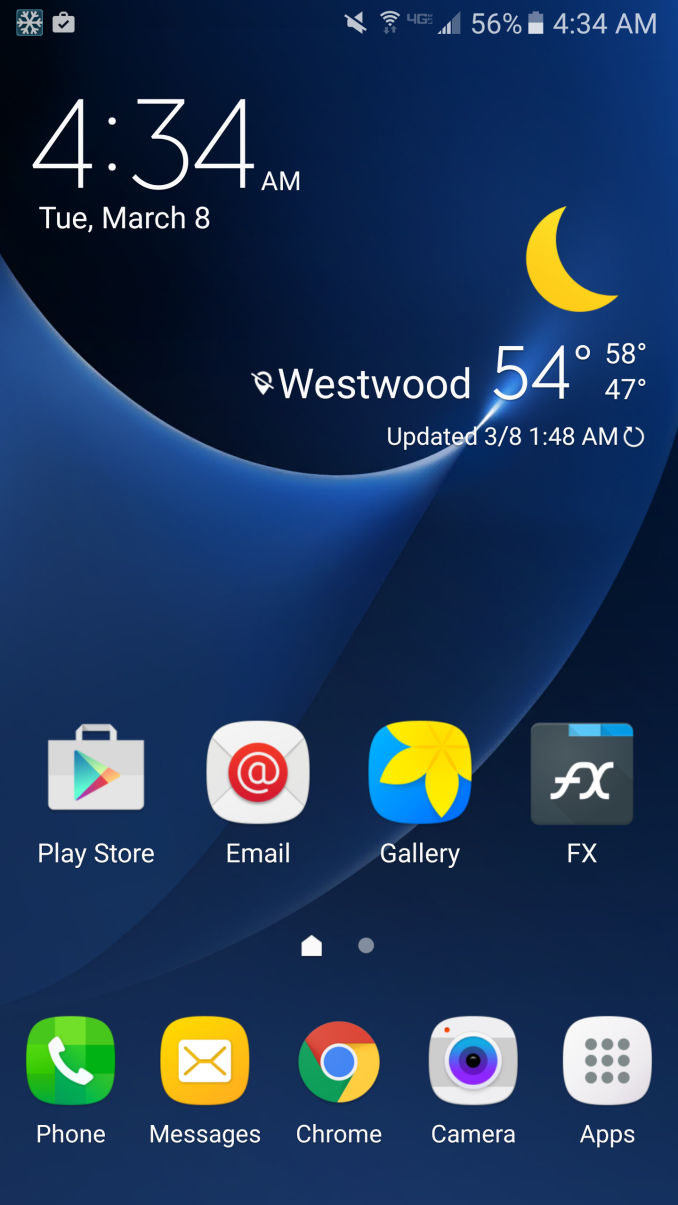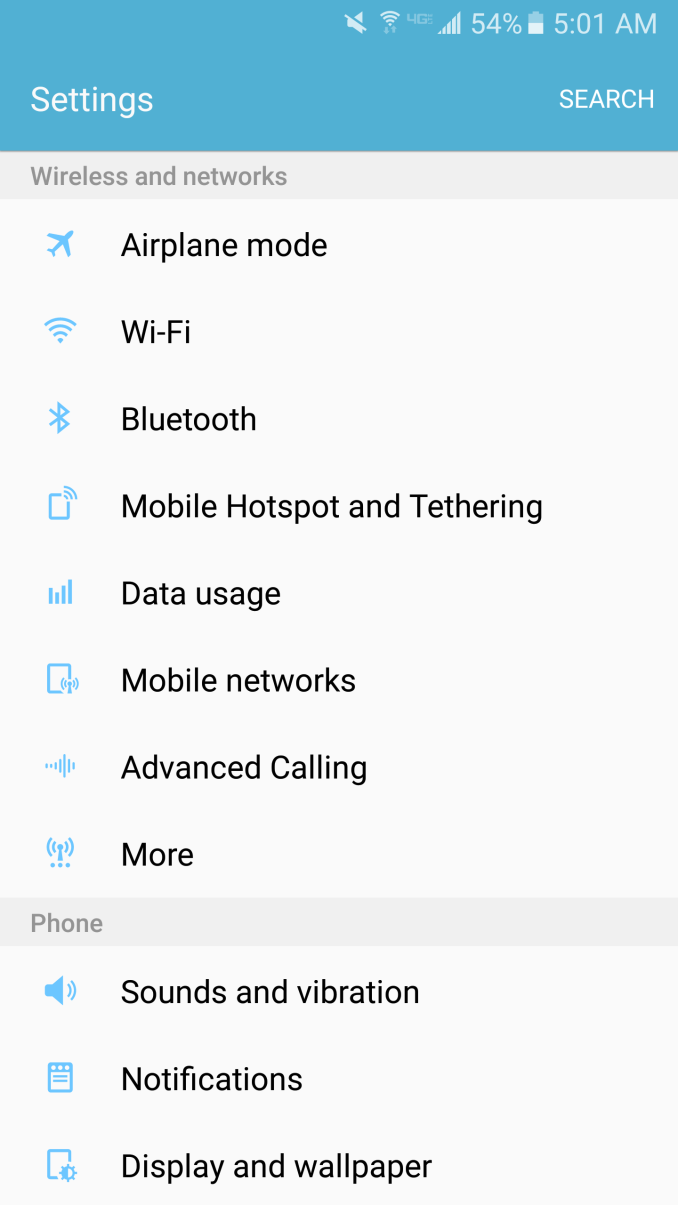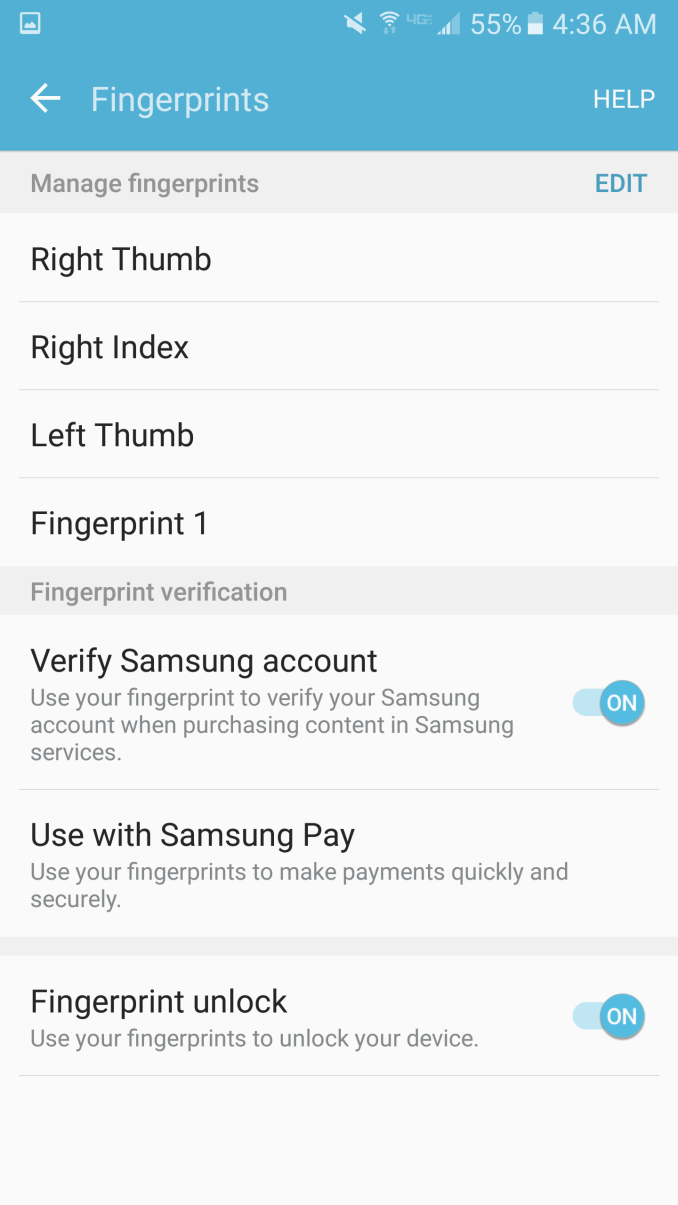The Samsung Galaxy S7 & S7 Edge Review, Part 1
by Joshua Ho on March 8, 2016 9:00 AM ESTSoftware UX
As is always the case, there’s a perpetual debate over the role of the OEM when it comes to Android devices. For better or worse, Samsung seems to believe that they need to add their own framework and UI over Android. To some extent, I suspect that most users are going to find stock Android to be rather spartan out of the box, so it does make sense for OEMs like Samsung to continue adding their own custom applications and frameworks to help differentiate themselves from the competition.
With the Galaxy S5, it was evident that Samsung had dramatically changed their design direction for TouchWiz, but I would argue that their design aesthetic still wasn’t quite perfect, and performance wasn’t completely there either. With the Galaxy S6, Samsung had gotten closer to the mark in some ways, but the continued use of excessively neon colors just made parts of the UI feel off at times, and performance still wasn’t perfect.
With the Galaxy S7, performance has improved noticeably, but it’s really hard for me to say whether this is because Samsung has improved their codebase, or if a faster SoC is just making it harder to notice areas in need of optimization. At any rate, while the Galaxy S7 isn’t perfectly smooth - dropping frames now and then - it is sufficiently performant that you’re not going to find distracting lag.
The default theme of the Galaxy S7 continues to feel pretty similar to the Galaxy S6, so for the most part things are acceptable here, but the use of color is still a bit excessive as a number of icons still use neon colors rather than more neutral pastel colors. Of course, the theme store now has a number of Material Design themes, which greatly improve the situation. I installed one pretty much immediately, which helps make the device feel a lot better in everyday use. However, I’m still of the opinion that this is something that a user shouldn’t need to do out of the box, so this is an area where Samsung can improve.
The other features that Samsung touted for the Galaxy S7 are interesting, but I’m not really sure they’re all that well executed. Always-On Display is nice to have, but for some reason it's quite reluctant to turn off the display when the ambient light sensor and proximity sensor are covered. As a result I turned it off as it’s clearly going to be contributing to idle battery drain in situations where it shouldn’t.
I also found that the fingerprint scanner is pretty much identical to the one in the Galaxy S6, which isn’t entirely surprising as both identify themselves as a Synaptics fingerprint scanner. Both still seem to be quite sensitive to the initial training period and in my experience won’t really work all that well if you don’t cover your entire fingerprint effectively during that period.
Other than this, TouchWiz doesn’t really stand out in any way as of now. Of course, Samsung Pay will be interesting for me to try as I still regularly run into terminals that don’t support NFC in any shape or form, but I haven’t really been able to spend much time testing Samsung Pay yet. I don’t really find TouchWiz to be a bad thing at this point, but I’m not really sure it’s a good thing either. With a serious emphasis on optimization and a major aesthetic overhaul, it’s entirely possible that I could find myself saying quite differently in the near future, but for now if you found the Galaxy S6 and Note 5 OEM UIs to be usable you’ll find the Galaxy S7 to be usable as well.















202 Comments
View All Comments
Bluetooth - Wednesday, March 16, 2016 - link
In the NAND storage tests are some phones using decryption and other not?qasdfdsaq - Wednesday, March 23, 2016 - link
As far as I can tell, the S7 comes encrypted out of the box and you cannot turn encryption off, so FDE is its natural and only state.jerrylzy - Wednesday, March 16, 2016 - link
ARMv8 has AES instructions built-in, like AESE (ByteSub, ShiftRows, AddRoundKeys) AESMC (MixColumns), etc.. With this kind of hardware support FDE should not affect much of the NAND performance if Samsung actually uses them.tipoo - Wednesday, March 16, 2016 - link
Ars Technica got something near 100MB/s for random 4K reads, sup with that?jacksonjacksona - Thursday, March 17, 2016 - link
( www).(ajkobeshoes).(com )christian louboutin
jordan shoes $60-
handbag
AF tank woman
puma slipper woman
=====
( www).(ajkobeshoes).(com )
SirKronan - Saturday, April 30, 2016 - link
Please remove spammer...XmppTextingBloodsport - Saturday, March 19, 2016 - link
Good job ignoring both the audio subsystem and antennae functionality of this PHONE.XmppTextingBloodsport - Saturday, March 19, 2016 - link
All LTE phone reviews need an eye to SIP (volte) and their respective audio paths and or black magic deviationsguyhindle - Monday, March 21, 2016 - link
I just *can't* bring myself to drop > £600 on a handset that will last < 3 yearsmaxnix - Wednesday, March 23, 2016 - link
Dumb Comment Time: But one has to note that if Samsung had not abandoned field replaceable batteries, Page one would be a mere curiosity.Coincidentally, I cannot find a review for the original Note Edge. Did AnandTech whiff on this?